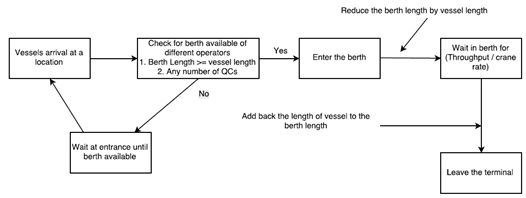Reference no: EM131437591
Simulation model to simulate the process flow in a container terminal
The objective of my project is to study the impact of different berth assignment rules (e.g. first come first serve, priority according to vessels volume, assign larger vessels to larger berths etc.) So through the simulations of different berthing rules and I can obtain the key performance indicators of the container terminal, then to compare the advantages of different berthing rules.
The flow is that 5 types of vessels will arrive at the terminal with different frequencies and they are exponentially distributed. Different types of vessels have different probability for calling 1 of the 4 terminal operators and the probability is shown above. The model should check first if the specific operator have enough length and QC available for processing the vessels, if yes, the vessel will enter the operator (locations), then the vessels will wait at the berth for processing (throughput / number of QC* crane rate) and then leave the terminal. If no space available, they will just wait at the beginning location until the specific operator is available.
Case 1: First Come first serve
Case 2: Larger vessels are processed first
Case 3: Assign vessels to idle berth first
Case 4: Assign smaller vessels to smaller berth first
You need to use the "attribute" function to define the length, QC requirement and vessel throughput to check the availability of berth, and then assign them to different berth when they are empty. After checking the remaining berth length and QC amount, when a vessel enter the berth, the length and QC quantity should be deducted, use this approach to control the movement of vessels in the terminal.
Still other approach that can achieve the goal can be used, not just limited to this method.
Flow chart

Attachment:- Data.rar